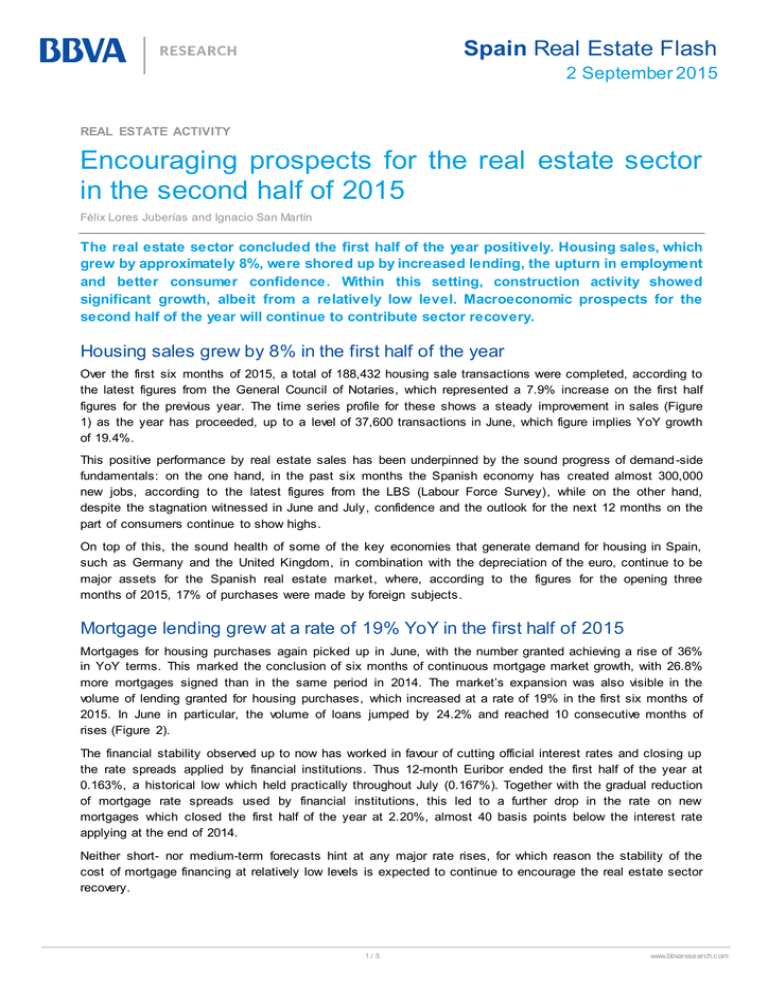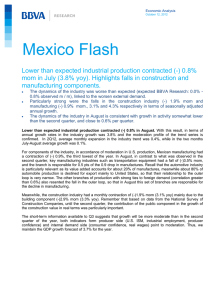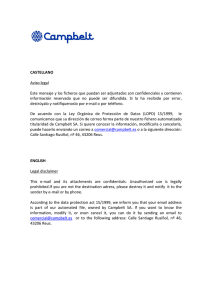Encouraging prospects for the real estate sector in the second half of
Anuncio

Spain Real Estate Flash 2 September 2015 REAL ESTATE ACTIVITY Encouraging prospects for the real estate sector in the second half of 2015 Félix Lores Juberías and Ignacio San Martín The real estate sector concluded the first half of the year positively. Housing sales, which grew by approximately 8%, were shored up by increased lending, the upturn in employment and better consumer confidence. Within this setting, construction activity showed significant growth, albeit from a relatively low level. Macroeconomic prospects for the second half of the year will continue to contribute sector recovery. Housing sales grew by 8% in the first half of the year Over the first six months of 2015, a total of 188,432 housing sale transactions were completed, according to the latest figures from the General Council of Notaries, which represented a 7.9% increase on the first half figures for the previous year. The time series profile for these shows a steady improvement in sales (Figure 1) as the year has proceeded, up to a level of 37,600 transactions in June, which figure implies YoY growth of 19.4%. This positive performance by real estate sales has been underpinned by the sound progress of demand-side fundamentals: on the one hand, in the past six months the Spanish economy has created almost 300,000 new jobs, according to the latest figures from the LBS (Labour Force Survey), while on the other hand, despite the stagnation witnessed in June and July, confidence and the outlook for the next 12 months on the part of consumers continue to show highs. On top of this, the sound health of some of the key economies that generate demand for housing in Spain, such as Germany and the United Kingdom, in combination with the depreciation of the euro, continue to be major assets for the Spanish real estate market, where, according to the figures for the opening three months of 2015, 17% of purchases were made by foreign subjects. Mortgage lending grew at a rate of 19% YoY in the first half of 2015 Mortgages for housing purchases again picked up in June, with the number granted achieving a rise of 36% in YoY terms. This marked the conclusion of six months of continuous mortgage market growth, with 26.8% more mortgages signed than in the same period in 2014. The market’s expansion was also visible in the volume of lending granted for housing purchases, which increased at a rate of 19% in the first six months of 2015. In June in particular, the volume of loans jumped by 24.2% and reached 10 consecutive months of rises (Figure 2). The financial stability observed up to now has worked in favour of cutting official interest rates and closing up the rate spreads applied by financial institutions. Thus 12-month Euribor ended the first half of the year at 0.163%, a historical low which held practically throughout July (0.167%). Together with the gradual reduction of mortgage rate spreads used by financial institutions, this led to a further drop in the rate on new mortgages which closed the first half of the year at 2.20%, almost 40 basis points below the interest rate applying at the end of 2014. Neither short- nor medium-term forecasts hint at any major rate rises, for which reason the stability of the cost of mortgage financing at relatively low levels is expected to continue to encourage the real estate sector recovery. 1/ 5 www.bbvaresearch.c om Spain Real Estate Flash 2 September 2015 New home starts are growing apace, with a 28% increase in the first five months of the year In the first five months of the year, building activity stuck to the growth trend that began in late 2014 and which has led to a rise of 28.2% YoY in permits for new home builds approved by quantity surveyors . This is all despite the fact that in May, which is the last figure that is available, housing starts experienced a slight correction after the strong growth recorded in the previous month (Figure 3). A high rate of growth in construction starts has arisen in a context where new housing production had been at a low. This pick-up in activity has also been reflected in how other variables have performed, such as employment and investment. Thus, from the labour market perspective, the LFS figures for the first six months of the year show substantial employment growth in the sector (11.6% YoY at the end of the period), whereas in the second quarter this was more moderate than in the first. In this respect, figures for those registered with the Social Security system also indicate employment growth in the first half of the year (close to 5% YoY), with this easing in the latter part of the period. On the other hand, the national accounts for the second quarter of the year published by the INE show that growth intensified in residential investment, this time arriving at a rate of 1.3% QoQ, which means that progress has been made for six straight quarters . The opinion of the business community with respect to future developments in the sector has become more positive over the first few months of the year, as can be deduced from the construction business climate index (Figure 4). In fact, for the residential segment of this index, this is now at levels akin to those at the outset of the crisis. The outlook for the second half of 2015 is bright, though not free of risk The figures for the first half of the year and the short term forecasts mean that we can remain optimistic about the sector’s progress in the second half of the year. Growth in economic activity, within a situation of financial stability that will continue to encourage increased lending at relatively low rates , will mean that inroads can be made into job creation and restoring consumer confidence, which are key to housing sales growth in the second half of the year. Meanwhile, real estate activity will continue to be buttressed by demand growth and the gradual take-up of the overhang of new housing, above all in the chief areas of economic activity, which will allow it to close the year with notable growth, although this is from a relatively low base. As a result, prices are expected to hold steady, as rising demand, in a context of a reduction of stocks on the supply side and relative financial stability , will help bring about a slow but sure recovery in real estate prices. This said, the sector’s progress is not free from risks. As with the economy as a whole, the uncertainty associated with political stability in Spain and the fallout that might come from the economic instabili ty that has arisen in the emerging markets (mainly China) could slow down the pace of the real estate market’s recovery. 2/ 5 www.bbvaresearch.c om Spain Real Estate Flash 2 September 2015 Figure 2 Spain: lending granted for new housing-purchase transactions (% YoY) Figure 1 60 40,000 40 35,000 20 30,000 0 25,000 Spain: construction climate index Total CCI Source: BBVA Research based on the Ministry of Public Works Jun-15 Jul-15 May-15 Mar-15 Jan-15 Nov-14 Sep-14 Jul-14 May-14 Mar-14 Jan-14 Nov-13 Sep-13 Jul-13 May-13 1,000 Jan-15 Jul-13 1,500 Nov-14 2,000 Sep-14 2,500 Jul-14 3,000 May-14 3,500 Mar-14 4,000 Jan-14 0 -10 -20 -30 -40 -50 -60 -70 -80 -90 -100 Nov-13 4,500 Apr-15 Figure 4 Spain: permits for new home builds (swda) May-15 Figure 3 Feb-15 Dec-14 Source: BBVA Research based on the Bank of Spain Millares Source: BBVA Research based on CIEN Mar-15 Oct-14 Aug-14 Jun-14 Apr-14 Feb-14 Dec-13 Oct-13 Jun-13 Apr-15 Jun-15 Feb-15 Dec-14 Oct-14 Jun-14 Aug-14 Apr-14 -80 Feb-14 5,000 Oct-13 -60 Dec-13 10,000 Jun-13 -40 Aug-13 15,000 Aug-13 -20 20,000 Sep-13 Millares Spain: housing sales (figures swda) Housing CCI Source: BBVA Research based on MINETUR 3/ 5 www.bbvaresearch.c om Spain Real Estate Flash 2 September 2015 Table 1 Spain: real estate sector indicators Aug Sept 14 14 Oct 14 Nov 14 Dec Jan 14 15 Feb 15 Mar 15 Apr May Jun July 15 15 15 15 Sales (%, MoM sw da) -4.5 11.5 -0.8 -3.8 26.2 -24.1 8.4 5.8 -3.0 -2.1 6.7 0.2 0.2 0.4 0.4 0.2 0.4 0.5 0.4 0.3 0.1 0.1 Unemployment (%, MoM sw da) -0.4 -0.7 -0.5 -0.7 -0.4 -0.8 -1.0 -1.1 -1.0 -0.8 -0.5 -1.0 Affiliations to the S.S. (%, MoM sw da) 0.1 Dem and variables Employment LFS (%, QoQ sw da) 0.5 1.0 0.6 0.9 Unemployment rate (% Labour force) 23.7 23.7 23.8 22.4 Interest rate of new operations (%) 2.93 2.96 2.87 2.72 2.56 2.58 2.49 2.34 2.28 2.28 2.20 New loan for house purchase (%, YoY) -3.9 29.4 22.1 32.5 47.7 Gross disp. income (%, YoY) 2.8 Consumer confidence (index) 9.5 5.6 Affordability (% household income) Supply variables Cement consumption (%, MoM sw da) -1.9 Affiliations to the S.S. in const. (%, MoM sw da) 0.3 3.7 -1.3 35.5 Permits (%, MoM sw da) -7.1 -11.2 5.4 14.5 20.1 23.1 23.4 24.2 3.5 5.8 3.2 11.6 14.4 16.1 18.4 17.6 13.3 10.5 34.8 32.5 5.4 -22.2 -20.7 106.1 5.6 -29.1 52.4 -9.4 0.9 2.5 -0.2 1.3 -0.2 -0.2 1.7 1.2 0.9 0.1 0.5 0.8 0.6 0.4 1.1 0.6 0.3 0.4 -0.1 0.0 Unemployment in const. (%, MoM sw da) -1.4 -1.5 -1.7 -1.7 -1.0 -2.1 -2.1 -1.6 -2.4 -1.6 -1.3 -1.5 Business climate in construction (index) -44.5 -33.3 -44.3 -45.5 -44.0 -42.1 -37.4 -26.7 -30.7 -37.9 -21.2 -33.8 Price Land sales (%, YoY) 21.0 2.7 4.4 Housing price (%, YoY MFOM) -2.6 -0.3 -0.1 Housing price (%, QoQ MFOM) -0.5 0.5 -0.1 Housing price index (%, YoY INE) 0.3 1.8 1.5 Housing price index (%, QoQ INE) -0.3 0.2 0.7 Source: BBVA Research based on national databases Closing date: 1 September 2015 4/ 5 www.bbvaresearch.c om Spain Real Estate Flash 2 September 2015 AVISO LEGAL El presente documento, elaborado por el Departamento de BBVA Research, tiene carácter divulgativo y contiene datos, opiniones o estimaciones referidas a la fecha del mismo, de elaboración propia o procedentes o basadas en fuentes que consideramos fiables, sin que hayan sido objeto de verificación independiente por BBVA. BBVA, por tanto, no ofrece garantía, expresa o implícita, en cuanto a su precisión, integridad o corrección. Las estimaciones que este documento puede contener han sido realizadas conforme a metodologías generalmente aceptadas y deben tomarse como tales, es decir, como previsiones o proyecciones. La evolución histórica de las variables económicas (positiva o negativa) no garantiza una evolución equivalente en el futuro. El contenido de este documento está sujeto a cambios sin previo aviso en función, por ejemplo, del contexto económico o las fluctuaciones del mercado. BBVA no asume compromiso alguno de actualizar dicho contenido o comunicar esos cambios. BBVA no asume responsabilidad alguna por cualquier pérdida, directa o indirecta, que pudiera resultar del uso de este documento o de su contenido. Ni el presente documento, ni su contenido, constituyen una oferta, invitación o solicitud para adquirir, desinvertir u obtener interés alguno en activos o instrumentos financieros, ni pueden servir de base para ningún contrato, compromiso o decisión de ningún tipo. Especialmente en lo que se refiere a la inversión en activos financieros que pudieran estar relacionados con las variables económicas que este documento puede desarrollar, los lectores deben ser conscientes de que en ningún caso deben tomar este documento como base para tomar sus decisiones de inversión y que las personas o entidades que potencialmente les puedan ofrecer productos de inversión serán las obligadas legalmente a proporcionarles toda la información que necesiten para esta toma de decisión. El contenido del presente documento está protegido por la legislación de propiedad intelectual. Queda expresamente prohibida su reproducción, transformación, distribución, comunicación pública, puesta a disposición, extracción, reutilización, reenvío o la utilización de cualquier naturaleza, por cualquier medio o procedimiento, salvo en los casos en que esté legalmente permitido o sea autorizado expresamente por BBVA. 5/ 5 www.bbvaresearch.c om





